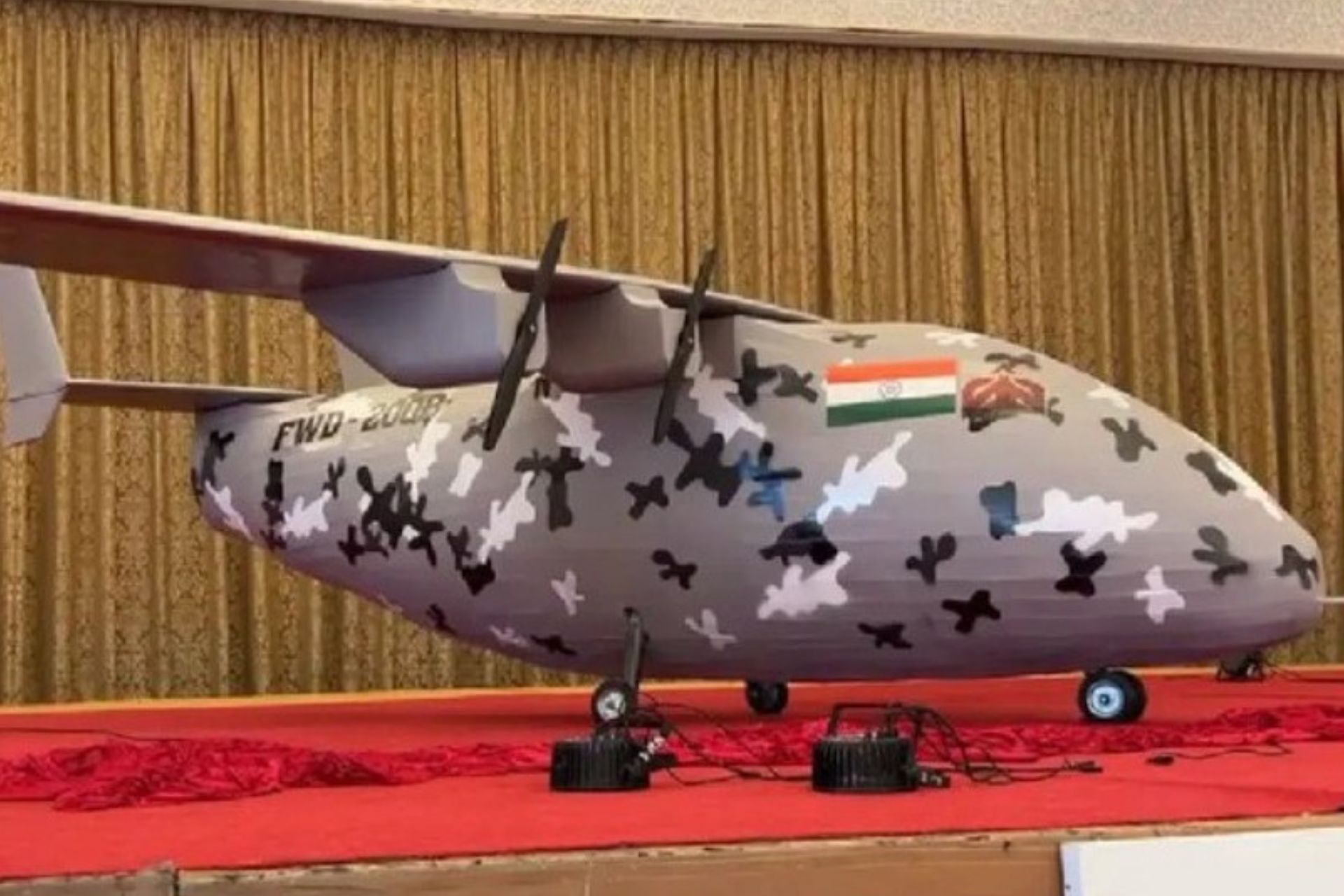Successful Maiden Flight of India’s FWD 200B Combat Drone Marks a Turning Point for Defense Industry

{loadposition bannertop}
{loadposition sidebarpub}
On September 3, 2024, Bengaluru-based company Flying Wedge Defence and Aerospace (FWDA) announced the successful maiden flight of the FWD 200B, the first unmanned combat drone fully developed in India. This event marks a significant advancement for the country’s defense sector, representing the achievement of a long-standing goal to produce an entirely indigenous combat drone.Follow Army Recognition on Google News at this link
The drone also has an endurance of 7 hours and can cover a distance of 800 km, ensuring extended mission durations without the need for frequent refueling or landing. (Picture source: Flying Wedge Defence)
The FWD 200B is classified as a Medium Altitude, Long Endurance Unmanned Combat Aerial Vehicle (MALE UCAV), capable of reconnaissance and aerial strike missions. It is equipped with optical payloads for surveillance and missile-like weapon systems for airstrikes and bombing, combining precision and effectiveness.
With a wingspan of 5 meters and a length of 3.5 meters, the FWD 200B stands out for its compact design while maintaining a high operational capacity. It has a maximum take-off weight of 102 kg and a payload capacity of 30 kg, allowing it to carry out significant missions. The aircraft operates at a cruise altitude of 12,000 feet and can reach a maximum altitude of 15,000 feet. It flies at a cruise speed of 152 km/h and can reach a maximum speed of 250 km/h. Its minimum runway requirement of only 300 meters makes it particularly suitable for operations from short airstrips.
The drone also has an endurance of 7 hours and can cover a distance of 800 km, ensuring extended mission durations without the need for frequent refueling or landing.
The FWD 200B was successfully tested at a confidential site, and its maiden flight represents a major technological advancement for India. This project, led by FWDA, is the result of sustained efforts to develop an indigenous combat drone, overcoming technical challenges that had previously hindered similar initiatives within the country.
Suhas Tejaskanda, founder and CEO of FWDA, expressed his satisfaction during a press conference, stating: “India, being the world’s largest arms importer over the past five years, has often paid significant sums to access military technologies from countries like the United States and Israel. The success of the FWD 200B flight is an accomplishment not only for our company but for the entire nation.”
With negotiations for Turkey’s Bayraktar drone failing and the U.S. Predator deal being on hold for two years, the development of this indigenous aircraft takes on particular significance.
The aerodynamic design, airframe, propulsion systems, control systems, and electronics of the FWD 200B were all developed locally at FWDA’s production facility located in Electronic City, Bengaluru. According to Tejaskanda, this achievement is the result of many years of efforts to overcome obstacles that had previously impeded the development of similar technologies by Indian defense agencies.

{loadposition bannertop}
{loadposition sidebarpub}
On September 3, 2024, Bengaluru-based company Flying Wedge Defence and Aerospace (FWDA) announced the successful maiden flight of the FWD 200B, the first unmanned combat drone fully developed in India. This event marks a significant advancement for the country’s defense sector, representing the achievement of a long-standing goal to produce an entirely indigenous combat drone.
Follow Army Recognition on Google News at this link
The drone also has an endurance of 7 hours and can cover a distance of 800 km, ensuring extended mission durations without the need for frequent refueling or landing. (Picture source: Flying Wedge Defence)
The FWD 200B is classified as a Medium Altitude, Long Endurance Unmanned Combat Aerial Vehicle (MALE UCAV), capable of reconnaissance and aerial strike missions. It is equipped with optical payloads for surveillance and missile-like weapon systems for airstrikes and bombing, combining precision and effectiveness.
With a wingspan of 5 meters and a length of 3.5 meters, the FWD 200B stands out for its compact design while maintaining a high operational capacity. It has a maximum take-off weight of 102 kg and a payload capacity of 30 kg, allowing it to carry out significant missions. The aircraft operates at a cruise altitude of 12,000 feet and can reach a maximum altitude of 15,000 feet. It flies at a cruise speed of 152 km/h and can reach a maximum speed of 250 km/h. Its minimum runway requirement of only 300 meters makes it particularly suitable for operations from short airstrips.
The drone also has an endurance of 7 hours and can cover a distance of 800 km, ensuring extended mission durations without the need for frequent refueling or landing.
The FWD 200B was successfully tested at a confidential site, and its maiden flight represents a major technological advancement for India. This project, led by FWDA, is the result of sustained efforts to develop an indigenous combat drone, overcoming technical challenges that had previously hindered similar initiatives within the country.
Suhas Tejaskanda, founder and CEO of FWDA, expressed his satisfaction during a press conference, stating: “India, being the world’s largest arms importer over the past five years, has often paid significant sums to access military technologies from countries like the United States and Israel. The success of the FWD 200B flight is an accomplishment not only for our company but for the entire nation.”
With negotiations for Turkey’s Bayraktar drone failing and the U.S. Predator deal being on hold for two years, the development of this indigenous aircraft takes on particular significance.
The aerodynamic design, airframe, propulsion systems, control systems, and electronics of the FWD 200B were all developed locally at FWDA’s production facility located in Electronic City, Bengaluru. According to Tejaskanda, this achievement is the result of many years of efforts to overcome obstacles that had previously impeded the development of similar technologies by Indian defense agencies.







